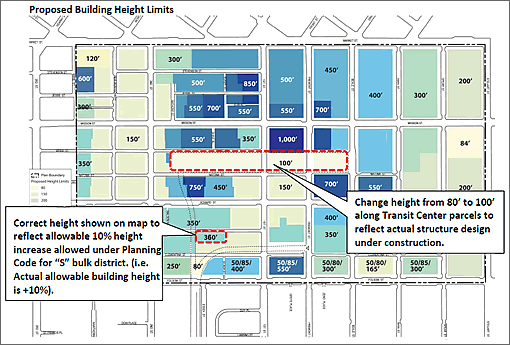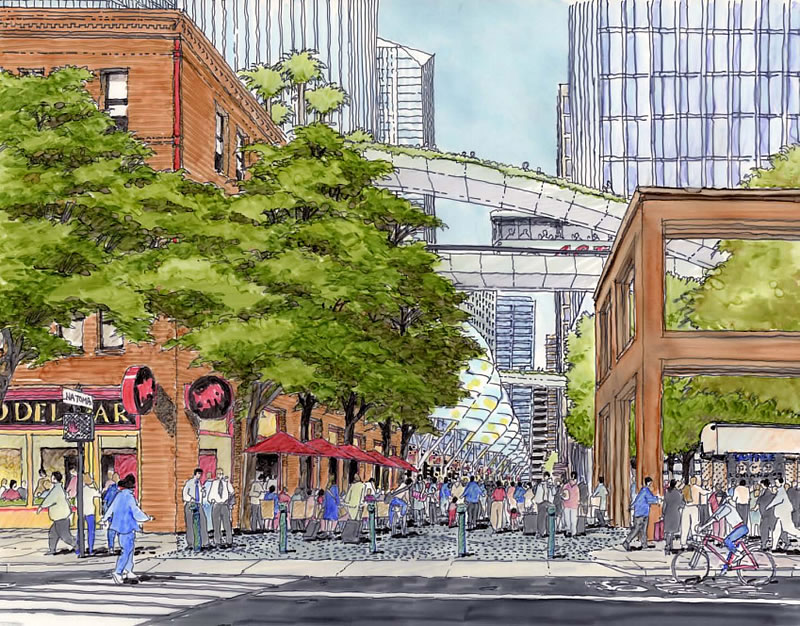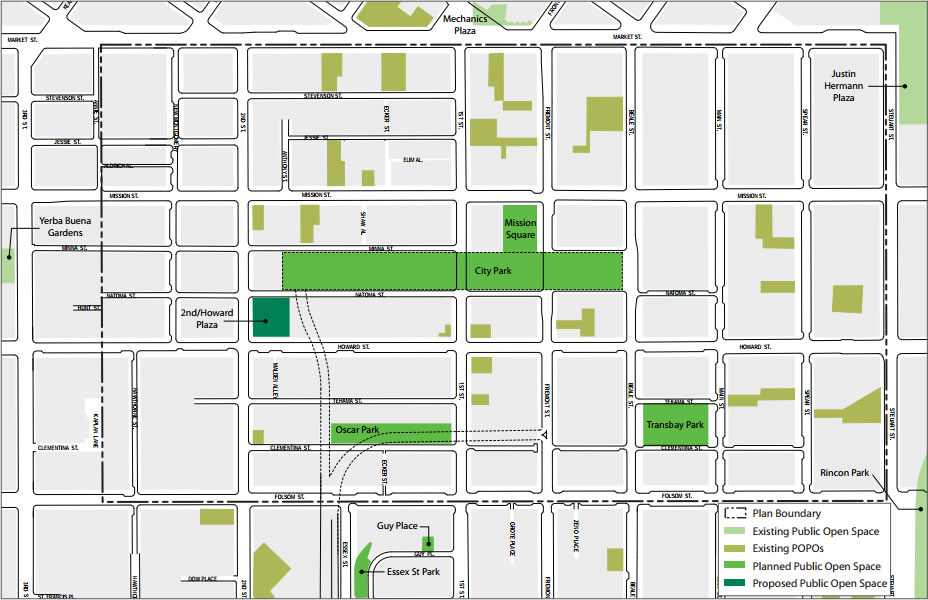First drafted in 2009, the Planning Department’s Transit Center District Plan for the area bounded by Market, Steuart, Folsom, and mid-block between 3rd and New Montgomery is making the Planning Commission rounds this week to prepare for a public hearing on the adoption and implementation of the amended plan currently scheduled for May 24.
Once again, the plan’s five Core Goals:
1. Build on the General Plan’s Urban Design Element and Downtown Plan, establishing controls, guidelines, and standards to advance existing policies of livability, as well as those that protect the unique qualities of place.
2. Capitalize on major transit investment with appropriate land use in the downtown core, with an eye toward long-term growth considerations.
3. Create a framework for a network of public streets and open spaces that support the transit system, and provides a wide variety of public amenities and a world-class pedestrian experience.
4. Generate financial support for the Transbay Transit Center project, district infrastructure, and other public improvements.
5. Ensure that the Transit Center District is an example of comprehensive environmental sustainability in all regards.
Core recommendations of the plan include: identifying and funding opportunities for new public open spaces (including an expanded Oscar Park); widening sidewalks, providing dedicated transit lanes, augmenting the bicycle network, adding signalized mid-block crosswalks, and converting certain alleys into pedestrian plazas; and, of course, increasing allowable density and height limits within the Plan area.



Not sure what the “2nd/Howard Plaza” is about (shown in pic above with skeleton of building around it):
Does it give access to the park 70-feet up above the terminal?
Is it worth carving a hole in the one vibrant neighborhood commercial street in SOMA, and tearing down nice buildings like 85 Natoma?
Was it grabbed with imminent domain?
Such a great project, can’t wait to see it take shape as well as see HSR and Caltrain in here too. If a few private property owners have to be justly compensated via EMINENT domain, so be it. It’s for a much greater good, not only for the immediate vicinity but also for every other place in the Bay Area and in California that are touched by Caltrain and HSR. Build it. And sooner = cheaper, so HURRY UP, we’re not all gonna be here forever!
I believe they had to remove everything on that corner to enable CalTrain to come into the terminal.
I wonder how they can up-level the height limits of all those properties to the south of the terminal without breaking the shadow ordinance on the new Transbay park. Is there an exemption built into the plan?
“I believe they had to remove everything on that corner to enable CalTrain to come into the terminal.”
And amazing (and sad) that unless current plans change, HSR and Caltrain will never actually reach the new terminal…just 4th and King.
And even if HSR does come to 4th and King it’s still not for 20 more years if all goes according to plan.
HSR is going to reach the new terminal, they are just having trouble arranging for the funding. Even if it takes a few extra decades to build out the rail and get the terminating stations right, then it will still be worth it.
And amazing (and sad) that unless current plans change, HSR and Caltrain will never actually reach the new terminal…just 4th and King.
While not necessarily binding, as we reported in March: “Last week, a plan to spend $1.5 billion dollars to electrify Caltrain by way of a mix of bonds, tax revenue and federal grants was agreed upon and included a “pledge by Bay Area leaders to build a 1.2-mile tunnel through downtown San Francisco to connect the line to the new Transbay Terminal.”
I wonder if folks on the Peninsula realize that their property values would increase if trains were to reach the new Transbay terminal. I, for one, would be much more willing to buy a house on the Peninsula if I knew my commute into downtown San Francisco would be easy on the S.F. end. As it stands, I would never willingly sign up to take the Caltrain every day if it got me only as far as 4th & King. (The Central Subway into Union Square wouldn’t help me, either.) Hence, our decision last year to buy a house in the City.
Its a pathetic testimonial to the current state of the country when it will take us 20 or 30 years to build a high speed rail line that would be built in China in 2 years.
If you want pathetic then look at the BART to San Jose extension. Over thirty years in planning and they are just now breaking ground on a project that won’t even make it into downtown San Jose. And we’re talking 1960s technology here.
The problem with building Big Transit in the USA is that it requires a solid mandate from the public to get the process rolling. And then that public mandate needs to stay strong throughout the extended EIR process. Meanwhile smaller projects to expand the dead-end highway mode transportation chip away at funds from multiple angles while simultaneously addicting the public further.
If we want Big Transit projects implemented faster we’ll need to curb the highway dog. Phasing out road subsidies would be a great start.
Yes if only we could be more like China and not give the public any say on what the government does and then jail anyone that does dissent. It would greatly speed up our public works projects.
“Its a pathetic testimonial to the current state of the country when it will take us 20 or 30 years to build a high speed rail line that would be built in China in 2 years.”
While it’s hard not to admire the ability to China execute on something like their ability to build out a HSR line in 2 years, it is an interesting comment when juxtaposed with one of the week’s top news stories about the blind Chinese activist seeking refuge in the U.S. embassy in China (and who now wants to leave the country outright).
Where would you rather live?
I think that there’s a balance between the Chinese two year “ram it down their throats” style of central planning and our analysis paralysis that enriches consultants and lawyers while draining tax monies and delivering nothing.
The EIR process has been corrupted so bad that it can actually be used to prevent environmental improvement in some cases like the SF bike plan injunction. Plaintiffs who use the EIR to halt projects that deliver long term benefit on the grounds that there’s short term impact should be fined. Or at least have a special place reserved for them in hell.
Both the BART extension into San Jose and the HSR have the same set of NIMBY opponents in common: a small group of Palo Alto residents who hate all progress of any type and are smart and wealthy enough to drag every project through endless lawsuits. Too bad we can’t put them in jail like they do in China.
This Transbay district plan is impressive and ambitious, but strangely, almost unrealistically so. Like a “fake it til you make it” approach to urban planning.
NoeValleyJim = I don’t think that the Palo Alto-MP-Atherton gang is opposing BART to San Jose since that route goes nowhere near their back yards. There are nimbys opposing BART to SJ but they don’t have nearly the capital as the peninsula.
While I could go either way on the dissent issue (I jest — sorta), this is what worries me about China: A section of an unopened high-speed railway collapsed in central China’s Hubei province following heavy rains, renewing safety concerns prompted by a fatal crash last year.